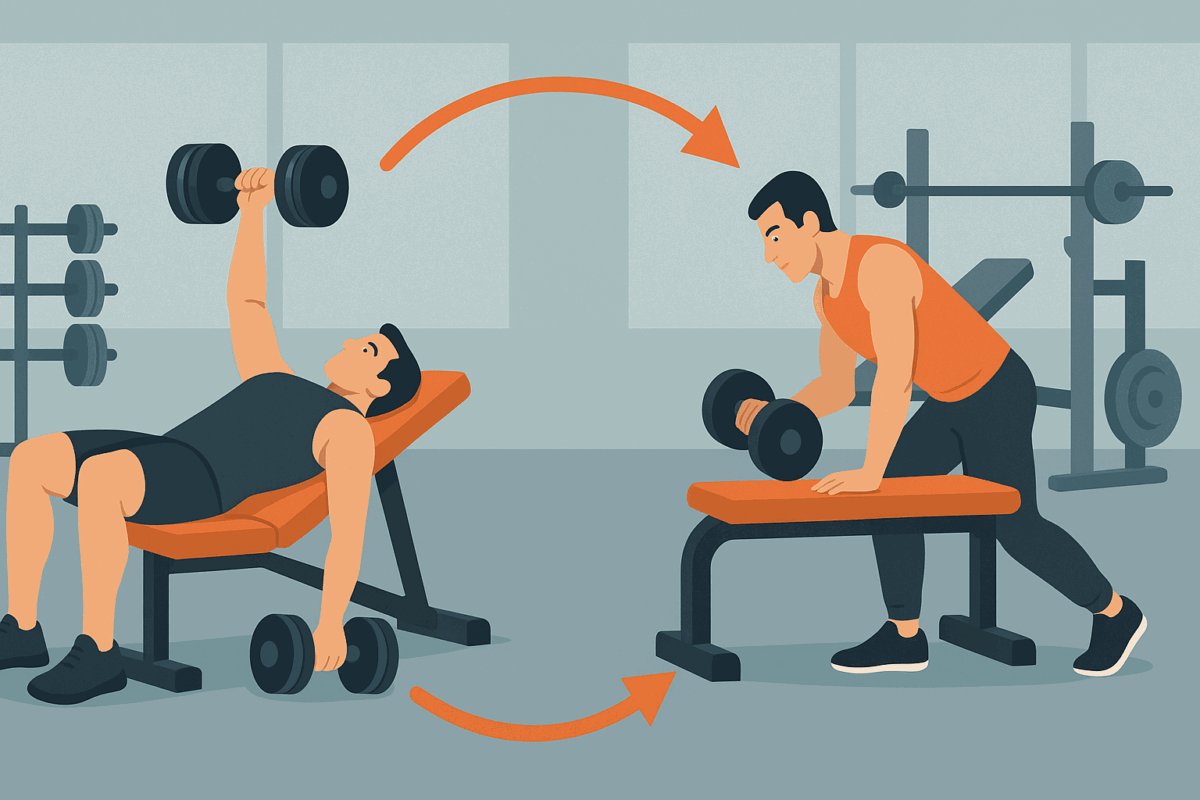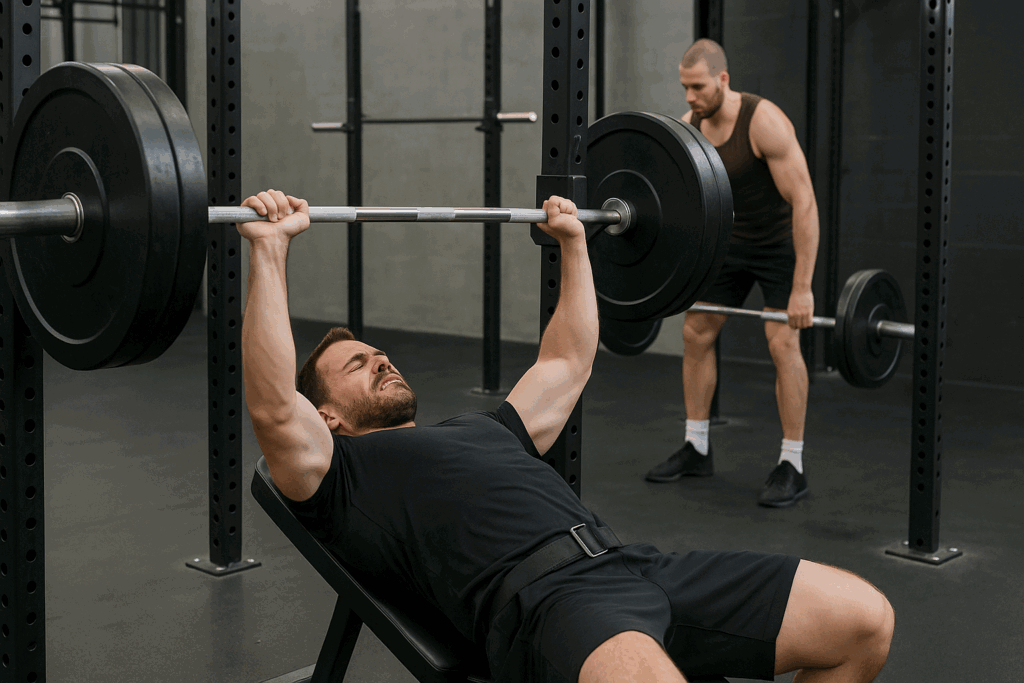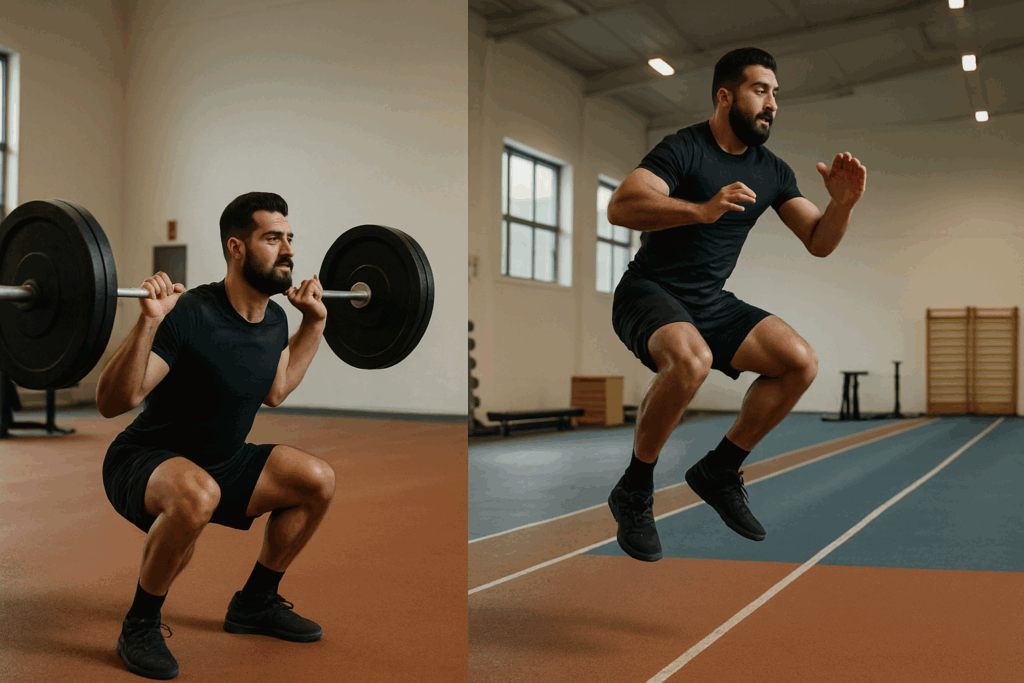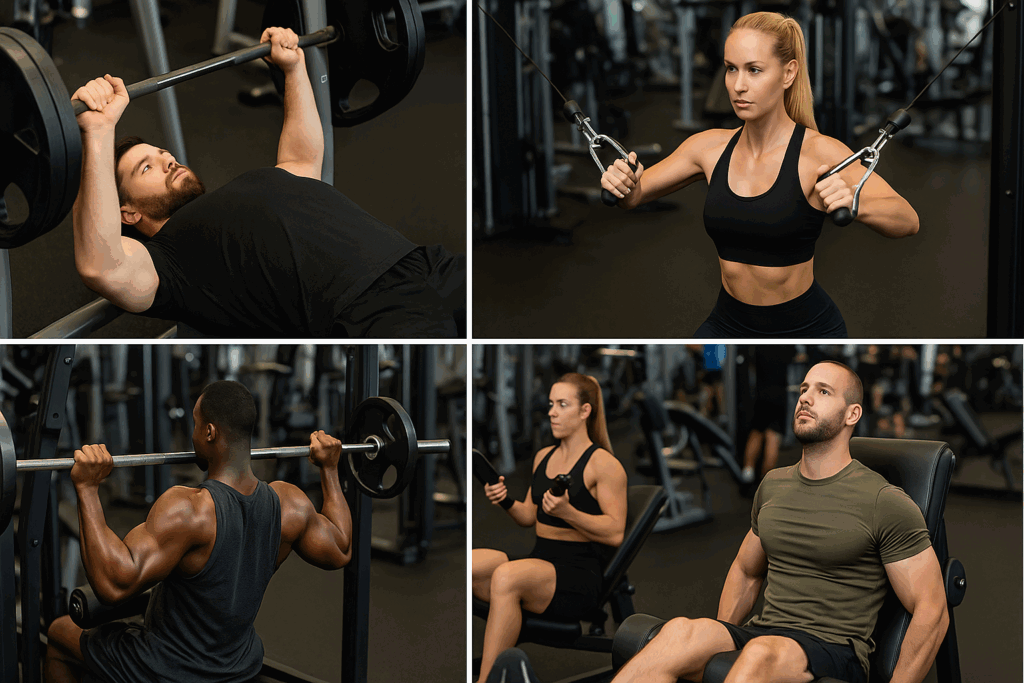Introduction: Exploring the Science and Strategy Behind Supersets
Among advanced lifting techniques gaining traction in strength training and bodybuilding circles, few are as discussed or debated as supersets. Whether in commercial gyms or university weight rooms, athletes frequently integrate this approach to optimize time and stimulate hypertrophic adaptation. But the critical question remains: do supersets build muscle effectively? While anecdotal success stories abound, evidence-based insight is essential for separating training trends from scientifically sound strategies. As we explore the biomechanics, hormonal responses, and programming implications of supersets, this article will not only define what a superset is but also examine how and when it works best for muscle development.
The appeal of supersets lies not only in their efficiency but also in their perceived capacity to enhance muscular endurance, hypertrophy, and metabolic conditioning. From experienced lifters seeking a fresh challenge to time-strapped athletes aiming to maximize results in fewer sessions, the versatility of this method is compelling. Still, the value of this approach must be assessed through the lens of evidence-based performance science. In doing so, we can better understand how super sets work, what a superset means in different contexts, and how best to implement superset routines in ways that deliver measurable gains.
You may also like: Unlock Peak Strength with This Expert-Designed 12 Week Powerlifting Program PDF
What Is a Superset in Weight Training? Clarifying the Definition and Purpose
Understanding the superset meaning starts with a basic definition: a superset is a strength training method where two exercises are performed back-to-back with minimal to no rest in between. Superset workouts typically target either opposing muscle groups—known as antagonist supersets—or the same muscle group for intensified overload, termed agonist supersets. Both forms can be valuable depending on specific training objectives. In contrast to traditional sets, which are separated by a rest period, supersets promote continuous muscle engagement and time-efficient training.
The superset definition also encompasses variations beyond muscle grouping. Some programs incorporate compound sets, which target the same muscle group with two different exercises, and contrast supersets, where a strength-focused lift is paired with a power-based movement. Another commonly used type is the pre-exhaust superset, where an isolation movement precedes a compound exercise to fatigue the muscle beforehand. These forms each carry unique physiological implications and cater to different goals, whether hypertrophy, strength, or endurance.
In gym settings, supersets are frequently adopted in circuit-style programs or during hypertrophy blocks when the goal is to increase muscle size through volume and time-under-tension. While the term “superset” is sometimes loosely applied to describe any paired exercises, it is important to recognize its structured use within the scientific and strength coaching communities. By standardizing what is a superset in weightlifting, trainers and lifters can better design programs that leverage its intended benefits.

Do Supersets Build Muscle? Investigating the Scientific Evidence
The question “do supersets build muscle” is foundational to understanding their value in hypertrophy-focused training. Emerging studies suggest that supersets can be highly effective for muscle building, particularly when programmed with intelligent structure and sufficient intensity. One of the primary mechanisms by which supersets stimulate hypertrophy is through increased metabolic stress—a known driver of muscle growth. When two exercises are performed consecutively, the accumulation of lactate and hydrogen ions creates a hypoxic environment that may promote anabolic signaling pathways.
Furthermore, supersets enhance time-under-tension, especially in agonist-focused variations. This prolonged mechanical load has been shown to trigger muscle protein synthesis, particularly when combined with progressive overload and adequate nutritional support. Some research also indicates that super setting meaningfully elevates acute hormonal responses, including spikes in growth hormone and testosterone. While these hormonal shifts are transient, they may contribute incrementally to long-term hypertrophic adaptation when training is consistently applied.
A 2010 study published in the Journal of Strength and Conditioning Research compared traditional resistance training to superset training and found that the latter group experienced similar or even superior gains in muscle size and endurance, with significantly reduced session time. However, it’s important to note that the effectiveness of superset exercises is contingent on proper programming. When overused or poorly planned, they may compromise performance or recovery. Thus, while the answer to “are supersets effective” is largely affirmative, context and design matter immensely.

Understanding the Superset Routine: Structuring for Strength and Size
Designing a successful superset routine requires attention to multiple variables including exercise selection, rest intervals, volume, and the sequencing of muscle groups. Supersets for muscle gain typically involve either antagonist or agonist muscle pairings, such as chest and back or biceps and triceps. These pairings allow for sustained intensity without prematurely fatiguing a specific muscle group, thereby maintaining quality across sets.
To maximize hypertrophy, it’s advisable to use moderate rep ranges (8–12 reps) with loads that elicit near-failure by the final repetition. Supersets can be integrated throughout a workout or used strategically at the beginning or end of a session to emphasize certain muscle groups. For example, including a pre-exhaust superset like dumbbell flyes followed by bench press can be a potent stimulus for chest development. This method forces the pectorals to work harder during compound lifts, enhancing recruitment.
Volume should also be monitored carefully. Because supersets shorten rest and increase cumulative fatigue, total weekly training load may need to be adjusted to avoid overtraining. Recovery strategies, including sleep, nutrition, and deload weeks, are especially important in programs heavily reliant on superset workouts. Moreover, the superset meaning extends beyond hypertrophy—it can be an effective tool for endurance athletes seeking muscular resilience, or for body recomposition goals where metabolic stress is prioritized over maximal strength.

Are Supersets Effective for Strength Development?
While supersets are widely known for their hypertrophic benefits, their role in pure strength development is more nuanced. Traditional strength training emphasizes long rest periods, heavy loads, and low rep ranges to optimize neuromuscular adaptations. In contrast, supersetting may interfere with maximal force production due to elevated fatigue and shorter rest intervals. However, there are exceptions and strategic ways to incorporate supersets without compromising strength.
One such method is using antagonist-pair supersets, such as pairing a bench press with a barbell row. This approach can enhance neural efficiency by promoting reciprocal inhibition, allowing opposing muscles to recover as their counterparts work. This can maintain training intensity while improving motor unit recruitment. Some studies suggest that alternating opposing muscle groups in supersets can preserve force output and improve total work performed within a session.
Additionally, strength-focused lifters may use supersets during assistance work rather than main lifts. For instance, following a heavy deadlift session with supersets of hamstring curls and glute bridges can reinforce posterior chain strength without interfering with central nervous system recovery. Therefore, while the primary application of superset exercises may be hypertrophy and muscular endurance, they can also support strength development when applied judiciously.

Super Setting Meaning in Athletic and Conditioning Contexts
Beyond hypertrophy and strength, the meaning of supersets takes on expanded relevance in sports performance and conditioning programs. In athletic contexts, time efficiency and concurrent training demands often necessitate methods that deliver maximal results in limited windows. Supersets meet this requirement by allowing athletes to maintain high training density while addressing multiple physical qualities.
For example, a strength and conditioning coach may employ contrast supersets—pairing a heavy lift with an explosive movement—to develop both force and speed. A classic pairing is a heavy squat followed by a jump squat. This approach leverages post-activation potentiation (PAP), a phenomenon where muscular performance is temporarily enhanced following heavy loading. Over time, such strategies can improve power output, agility, and coordination.
Similarly, in metabolic conditioning circuits, supersets can elevate heart rate and energy expenditure while targeting specific muscle groups. This is especially valuable for athletes in weight-class sports or those seeking to maintain leanness during competitive phases. The inclusion of aerobic-based supersets, such as battle ropes followed by kettlebell swings, integrates muscular endurance with cardiovascular conditioning, making supersets a versatile tool for comprehensive athletic development.

Superset Workouts for Beginners vs. Advanced Lifters: Customizing the Approach
While the principles of superset workouts are broadly applicable, their implementation must vary between training populations. Beginners benefit from simplified antagonist supersets using machines or basic bodyweight movements. For instance, pairing seated rows with chest presses offers an efficient, manageable introduction to resistance training that encourages muscular balance and technique development.
In contrast, advanced lifters can leverage complex supersets that combine free-weight movements, isolation work, and multi-planar actions. For example, a seasoned athlete might pair Bulgarian split squats with Romanian deadlifts to create an intense posterior chain superset. These combinations demand greater neuromuscular coordination and energy management, making them suitable for those with a solid foundation in lifting mechanics.
Progression is key. New lifters should master traditional sets before adopting supersets to ensure proper form and load control. Over time, increasing the complexity and intensity of superset routines can promote continued adaptation and prevent plateaus. This individualized progression respects the lifter’s capacity while maximizing the benefits that super sets offer across different training stages.

What Does Superset Mean for Fatigue and Recovery?
One important consideration when discussing what a superset means in programming is its impact on fatigue and recovery. Because supersets reduce rest time and elevate intensity, they can contribute to significant cumulative fatigue—both muscular and systemic. This makes recovery strategies essential for sustaining long-term progress and avoiding overtraining.
Physiologically, supersets generate higher levels of lactic acid and cortisol compared to traditional resistance training. While these responses may support hypertrophy, they also increase the demand on recovery systems. Insufficient recovery can lead to stalled progress, elevated injury risk, and disrupted sleep or mood. Therefore, supersets should be balanced with adequate rest days, active recovery protocols, and stress management techniques.
Nutrition also plays a pivotal role. Post-workout meals should prioritize high-quality protein sources to support muscle repair, along with carbohydrates to replenish glycogen. Hydration and micronutrient intake, especially electrolytes and magnesium, further aid in recovery. Sleep optimization remains the most critical factor in managing fatigue—athletes engaging in frequent superset training should aim for 7–9 hours of quality sleep per night to maximize recovery and performance.
Where to Put a Superset in Your Workout for Maximum Benefit
Strategically deciding where to put a superset in your workout can significantly influence outcomes. Early placement in a session—especially pre-exhaust supersets—can heighten muscle activation for subsequent compound lifts. For example, performing lateral raises before overhead presses ensures greater deltoid recruitment throughout the lift. However, this approach may compromise performance if used too aggressively.
Mid-workout supersets are effective for maintaining intensity without overtaxing the nervous system. This phase is ideal for antagonist pairings that allow for continuous movement without undue fatigue. Alternatively, supersets placed at the end of a session can serve as metabolic finishers. Combining isolation movements for the same muscle group—such as preacher curls followed by hammer curls—maximizes the pump and reinforces hypertrophic signaling.
Ultimately, the placement of supersets should align with the lifter’s goals, energy levels, and session focus. Beginners may benefit from structured early placement with lighter loads, while advanced athletes can experiment with variable sequencing. Regardless of timing, ensuring proper warm-up and cooldown protocols remains essential for injury prevention and recovery.
Superset Exercises That Maximize Results: Proven Pairings for Growth
Selecting effective superset exercises requires both biomechanical insight and goal clarity. For hypertrophy, combining multi-joint and isolation movements allows for comprehensive stimulation of a muscle group. A classic example is barbell bench press followed by cable chest flyes, which targets the pecs through different mechanical angles and resistance profiles. This not only promotes fiber recruitment but also enhances time-under-tension.
Antagonist supersets, such as lat pulldowns paired with incline dumbbell presses, maintain high training intensity while minimizing local fatigue. These combinations are especially useful in full-body workouts or upper-lower splits, where time management and efficiency are priorities. Another valuable pairing is leg extensions with hamstring curls—ideal for targeting the quads and hamstrings in isolation, making them useful for rehabilitation or symmetry-focused training.
In athletic or functional contexts, integrating movement supersets like kettlebell swings with sled pushes reinforces total-body coordination and conditioning. The diversity of superset routines allows for endless combinations that can be tailored to specific needs, whether muscle growth, strength, or metabolic health. Program design should always consider movement planes, recovery demands, and individual goals.

The Role of Superset Workouts in Advanced Periodization Models
Advanced lifters often integrate superset workouts into larger periodization frameworks that cycle training variables for peak performance. Within a linear or undulating periodization model, supersets can be inserted during hypertrophy blocks to accumulate training volume and enhance metabolic adaptation. These blocks may last 4–6 weeks before transitioning to lower-volume, higher-intensity strength phases.
Supersets can also be used in contrast with heavier main lifts to provide a volume stimulus without overloading joints or the nervous system. For example, a lifter might begin a session with heavy front squats and conclude with quad-focused supersets to augment growth. This strategic layering ensures that all muscular and neural adaptations are addressed across a training cycle.
Furthermore, in conjugate models where multiple strength qualities are trained simultaneously, supersets support dynamic effort and repetition efforts on accessory days. The flexibility of supersets within these systems demonstrates their value not only as a hypertrophy tool but as a comprehensive element of elite program design. Proper periodization, however, remains essential to avoid chronic fatigue and ensure progressive overload.
Frequently Asked Questions: Advanced Insights into Supersets for Strength and Hypertrophy
1. Do Supersets Build Muscle More Effectively Than Traditional Sets?
While traditional sets offer focused intensity with ample rest, supersets provide a unique advantage by increasing total training volume and metabolic stress within a condensed time frame. When structured appropriately, supersets create greater muscular fatigue and intramuscular tension, both of which are essential stimuli for hypertrophy. In many cases, athletes find that combining agonist and antagonist movements in a superset routine leads to higher work output per session without overextending time in the gym. Additionally, supersets often enhance muscle fiber recruitment due to shortened recovery between exercises, promoting a denser, fuller muscular appearance over time. However, to maximize their muscle-building potential, supersets must be carefully programmed with attention to exercise order, load selection, and recovery protocols.
2. What Is a Superset in Weight Training and How Does It Differ From Circuit Training?
To define superset in the context of weight training, it refers to performing two exercises consecutively with minimal to no rest, typically targeting either the same or opposing muscle groups. This method contrasts with circuit training, which involves rotating through multiple exercises—often five or more—before repeating the sequence. The distinction lies in focus: superset workouts prioritize muscle-specific adaptation and hypertrophy, while circuits aim for overall cardiovascular conditioning and endurance. In supersets, the intensity and volume can be modulated more precisely to suit hypertrophy or strength development goals, whereas circuits usually sacrifice load capacity for continuous movement. Therefore, while both methods offer metabolic benefits, supersets provide a more targeted and customizable strategy for building strength and muscle mass.
3. Are Supersets Good for Long-Term Training Programs?
Supersets can play a powerful role in periodized training programs when used judiciously. While many lifters ask, “are supersets good for consistent strength development,” the answer depends on how they are cycled. In hypertrophy or deload phases, super sets allow for high training density with reduced mechanical loading, minimizing joint stress. In contrast, strength-focused blocks may incorporate supersets only during accessory work to preserve maximal force output on primary lifts. Over time, alternating superset phases with traditional strength protocols can prevent adaptation plateaus and overtraining, creating a dynamic, well-rounded training experience. Ultimately, the long-term effectiveness of a superset routine depends on intelligent sequencing, recovery management, and alignment with individual goals.
4. What Does Superset Mean in the Context of Muscle Fiber Recruitment?
The phrase “what does superset mean” often implies more than just sequencing—it signals an intentional strategy for amplifying neural drive and fiber recruitment. Superset exercises stimulate both slow-twitch and fast-twitch muscle fibers more aggressively due to sustained time-under-tension and decreased intra-set rest. This is particularly effective when combining a heavy compound movement with a high-rep isolation exercise targeting the same muscle group. The cumulative fatigue forces deeper fiber recruitment as the body compensates to maintain performance. Over time, this not only promotes muscle size but also enhances the coordination and firing efficiency of motor units, a crucial component for advanced lifters aiming to refine technique and control.
5. Where to Put a Superset in Your Workout for Maximum Neurological Benefit?
Placing a superset at the beginning of a session—especially with opposing muscle groups—can help improve neuromuscular activation and warm up complementary systems efficiently. For example, pairing chin-ups with overhead presses in the initial phase of training enhances scapular stability and thoracic extension, setting the tone for heavier lifts later. Mid-session supersets are best suited for volume work, allowing athletes to maintain high intensity without neural fatigue interfering with main lifts. Late-stage supersets, on the other hand, are ideal for maximizing metabolic fatigue, flushing the muscle with blood, and enhancing the “pump” effect that some research links to growth signaling. The decision of where to put a superset in your workout should align with the intended stimulus—whether it be neurological priming, hypertrophy, or metabolic conditioning.
6. How Does Super Setting Meaningfully Enhance Mind-Muscle Connection?
One of the often-overlooked benefits of super sets is the improvement of mind-muscle connection. By rapidly transitioning between exercises, especially those targeting the same muscle group, athletes become more attuned to the sensation of muscular contraction. This heightened awareness helps reinforce intentional movement patterns, allowing lifters to better isolate and fatigue specific regions of a muscle. For instance, a superset involving incline dumbbell presses followed by pec-deck flyes creates an intense, localized stimulus in the upper chest, which can help correct imbalances or lagging development. Furthermore, focusing on tempo during each phase of the superset routine—such as slowing down the eccentric phase—adds a layer of control that deepens muscular engagement and refines neuromotor pathways.
7. Are Supersets Effective for Fat Loss and Body Recomposition?
Yes, when programmed thoughtfully, supersets are extremely effective for fat loss and recomposition. The condensed structure of superset workouts elevates heart rate and caloric expenditure, offering both anaerobic and aerobic benefits in one session. For clients targeting body fat reduction while maintaining lean mass, combining upper-lower or push-pull supersets creates a metabolic overload that sustains elevated energy burn post-exercise. Unlike high-intensity interval training (HIIT), which often relies on cardio-based movements, super sets maintain a resistance component that preserves muscle tissue during caloric deficits. Additionally, the flexibility of a superset routine allows for customization based on diet phase, energy availability, and hormonal environment—making it ideal for athletes balancing aesthetics with performance goals.
8. How Does Superset Workouts Impact Hormonal Health and Recovery?
Superset workouts can significantly influence hormonal responses, both acutely and chronically. Immediately following an intense superset session, the body experiences an elevation in anabolic hormones such as testosterone and growth hormone, especially when large muscle groups are involved. This hormonal spike supports protein synthesis and recovery, but it also increases the demand on the central nervous system and endocrine function. Over time, consistently overloading the system without adequate rest can lead to elevated cortisol levels and impaired sleep quality. To safeguard hormonal health, it’s crucial to periodize superset sessions, manage training load, and support recovery with nutrition rich in antioxidants, zinc, and omega-3s. For women, balancing high-volume supersets with menstrual cycle phases may optimize recovery and prevent overtraining, reflecting the need for bio-individuality in superset application.
9. What Is a Superset in Weightlifting That Enhances Athletic Power?
In weightlifting, a superset designed to enhance athletic power typically pairs a high-load movement with a rapid, explosive action. This is known as a contrast superset, where exercises like trap bar deadlifts are immediately followed by vertical jumps or sled sprints. The concept leverages post-activation potentiation, where the nervous system becomes primed by the heavy lift, allowing the subsequent explosive movement to be more powerful and technically precise. For athletes in sports requiring quick acceleration, such as football or basketball, this style of superset training bridges the gap between maximal strength and functional speed. It’s important that these supersets are programmed with sufficient rest between rounds and guided by technical precision, as fatigue can impair motor learning and diminish the effectiveness of this advanced technique.
10. Do Supersets Build Muscle Even in Caloric Deficits or Cutting Phases?
A commonly asked question is whether do supersets build muscle during a cutting phase when calorie intake is reduced. The answer is yes—if structured correctly. While a caloric deficit typically limits the rate of muscle gain, supersets can maintain or even enhance lean mass by amplifying muscle fiber recruitment and mechanical stress in a shorter time. This makes them especially useful during diet phases when total training volume must be preserved despite reduced energy availability. By manipulating rest periods, load intensity, and exercise order, lifters can create a hypertrophic stimulus that mimics higher-calorie training outcomes. Additionally, supersets conserve time and energy, which is critical for adherence and sustainability during demanding nutritional phases, ensuring that training efficacy remains high even when resources are low.
Conclusion: Supersets as a Strategic Tool for Strength and Muscle Growth
In the pursuit of strength and muscle development, supersets emerge as a scientifically grounded and highly adaptable training method. Their ability to increase training density, elevate metabolic stress, and promote muscular hypertrophy is supported by both anecdotal success and academic research. The question “do supersets build muscle” can confidently be answered in the affirmative—provided that their use is grounded in intelligent programming and aligned with the individual’s goals.
The versatility of superset routines allows them to serve a range of purposes: from fat-burning circuits for conditioning, to volume-focused blocks for size, to efficient split sessions for busy athletes. By understanding what a superset means in its various forms—from antagonist to agonist pairings, from isolation to power movements—lifters can craft more effective, engaging, and sustainable training programs. Supersets are more than a trendy technique; they are a legitimate and powerful tool for those who understand how to wield them.
Whether you’re an aspiring bodybuilder, a recreational lifter, or a performance-driven athlete, the strategic integration of supersets can offer meaningful progress toward your fitness objectives. As with any method, success lies in the details—proper exercise selection, mindful sequencing, and diligent recovery. When applied with expertise and intention, supersets can indeed build muscle effectively and elevate the quality of any strength and conditioning program.
Further Reading:
What Is a Superset? Here’s How to Gain More Muscle in Less Time





